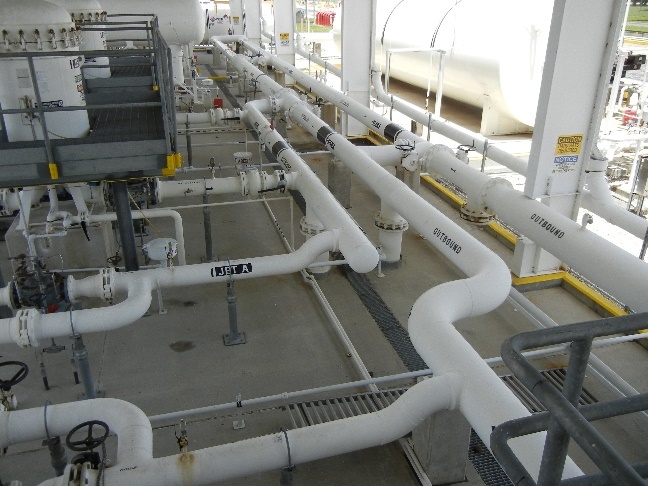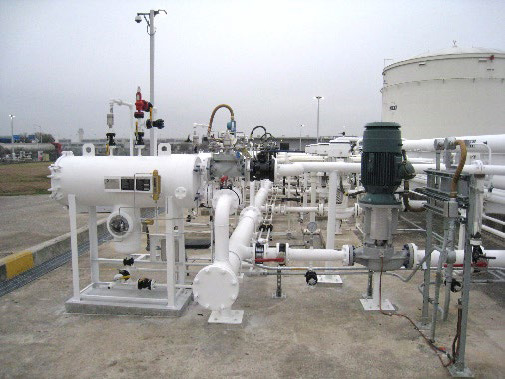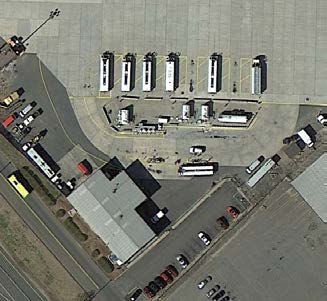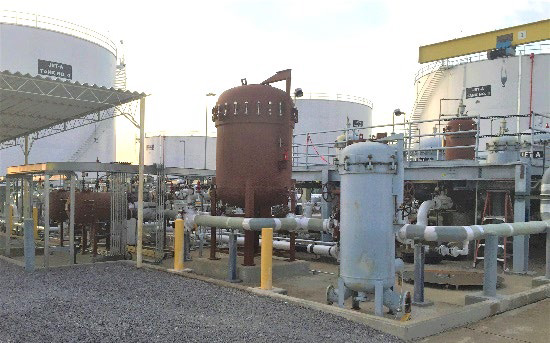

Currier & Company has been engaged in multiple design and construction projects within the MCO OFFL fuel facility since 2012 and is currently serving the OFFL Airline Consortium as their Airlines’ Representative for the new South Terminal Complex (STC) project.
Currier was selected to complete multiple projects at the in-service MCO Fuel Facility including 1) Due Diligence evaluations including code compliance analysis, risk management assessment, best practices comparisons and operational improvements, 2) Project Programming including options, alternative approaches, and negotiations with stakeholders/code officials, 3) Prime Design Services for the $8.5 million projects, and 4) Construction follow-on including resident engineering, fuel supply logistics management, and commissioning. This sweeping upgrade to the 9-million gallon fuel facility was fully coordinated with fuel receipts – 70% by pipeline and 30% by DOT Transport.
The project demanded uninterrupted fuel system operations, so precise phasing of construction was a project imperative. Bid documents were customized to suit competitive bidding while allowing early purchases of new systems and services including a Hansa Leak Detection system, mobile fire protection equipment, and specialized contracting services.
Major improvements included: a new 1600 square foot Operations Building including a new control system, user interface, control room, and specialized fire protection system to protect control systems and operators that are connected to an uninterrupted power supply/full generator back-up. A dedicated Fixed-Fire-Suppression system with factory fabricated proportioning skid to protect critical fuel supply system power and controls, pumping, fuel filtration, and suction/supply manifolds. A new facility-wide IR3 Fire Recognition system with integrated CCTV capability for operator monitoring, early fire detection, and video recording was included. A new first-responder loop road was provided along the site perimeter and a new fire main with high-capacity fire hydrants were placed in strategic areas of the facility to enhance firefighting water delivery capabilities. Primary power supply was re-routed below ground. Construction of a new Hansa Leak Detection system employing 50 new Double-Block-Bleed isolation valves for U/G piping pressure test evaluations (Florida compliant) was managed to minimize operational impacts.
New compliant Dike Cell Liners were added to suit NFPA 30 compliant cell arrangements, revised dike drainage/containment infrastructure and selected repairs to existing lining systems were all provided as well. To support early detection of facility upset conditions, additional temperature and vibration sensors were installed on existing fuel system pumps. A new EFSO Emergency Fuel Shut-Off system was designed and integrated into the controls. A facility lightning protection system and other improvements were included since the project came in under budget
As part of a routine hydrant system cathodic-protection system inspection, Currier found block valve vault #2 to have advanced stages of corrosion on piping, fasteners, and valves. This information was disseminated to the owner/operator and all parties agreed on the urgency to make an emergency repair to this critical pressurized infrastructure.
Currier was asked to design the repair/replacement of all affected parts inside of the vault. We were also asked to make sure that the surrounding storm sheet flow, be directed around the vault so that it no longer flowed directly into the vault. Due to the emergency nature of the project, Currier turned a complete mechanical, and structural design around in less than 2 weeks. This design was then reviewed with the Greater Orlando Aviation Authority (GOAA) and the Federal Aviation Administration. Once airport approvals were received, Currier & Company then expedited the drawings through the City of Orlando permitting.
Major improvements included: careful coordination with Menzies, the affected airlines, and the airport were required for partial outages to the primary hydrant fuel system. The vault modifications included the replacement of all valves and the majority of the large bore piping. This included (2) new 14” Double Block & Bleed (DBB) valves, and nearly (24) new small-bore valves for low point drains, highpoint vents, and pressure gauge lines. Some of the 14” mainline fuel piping needed to be replaced, as it was the only way to make the new arrangement work dimensionally. There was originally a crossover with spectacle blind in the vault. It was deemed necessary to remove this section of piping and replace it with a 180 degree turn-around piece. This turn-around piece would allow the twin fuel mains to better equalize, both pressure and velocity, to meet peak demands in localized sections of the hydrant fuel system. All low point drain and vault sump lines were relocated to a new access pit, to allow the operator to avoid having to enter the vault for routine maintenance of the fuel system. Additionally, the new 14” DBB valves received gear operator extensions, so they, too, could be operated without entering the vault.
After all mechanical improvements were completed, a new top slab was cast onto the tops of the vault walls. This top slab carried the main access hatch, housing the valve operators within, and the new low point sump pit. These will eliminate the need for personnel entry into the pit for routine operations, improving worker safety. This top slab also will prevent future water intrusion into the vault from storm sheet flow from the surrounding hillside. Keeping the pit dry will aide in the effort to avoid future corrosion issues within the structure.
As part of Currier’s hydrant system cathodic protection (CP) system inspection, Currier found that nearly all of the existing hydrant system main carrier pipe casings that cross under roadways, aircraft taxiways and runways have been compromised, and as a result of the high water table in the area, have experienced water intrusion. This condition caused the accelerated depletion of the existing galvanic anode cathodic protection system, which necessitated the need for the repair project. After presenting the findings of the CP inspection to the Owner, Currier was contracted in 2017 to develop options to ameliorate the issue associated with water intrusion and the depleted anode CP system. Currier’s final design proposed the addition of high-point and low-points to each casing, and the filling of the interstitial space between the carrier pipe and the casing pipe with a di-electric get, which will 1) purge the interstitial of water and 2) seal the interstitial space to eliminate future water intrusion, and therefore ceasing the corrosion of the carrier pipe within the casing. In addition, Currier with the assistance of Corrosion Controls Inc (CCI), the nation’s leading aviation NACE specialist, design a new sacrificial anode system to protect the mains despite the high-water table for decades to come.
Subsequent to design, Currier lead the permitting effort for this project with both GOAA and the City of Orlando. As part of this effort Currier developed the project’s FAA 7460, FAA required Construction Safety Phasing Plan and coordinated closely with the airport authority to schedule the future runway closures to complete the work. Currently, this project is out for bid and construction is scheduled to begin in the Fall of 2019.
In 2017, Currier was hired by the OFFL consortium to serve as the airlines’ fuel technical support and interface with GOAA throughout both the design and construction phases of the multi-phase GOAA project.
During the GOAA’s design phase, Currier reviewed the airport’s hydrant system design and provide comments to the airlines, the Orlando Airport Staff and the design engineer. Pulling on our extensive knowledge of the existing operation, the future expansion of the airport, and the associated fuel uplift demand, Currier performed a high-level steady-state hydraulic analysis. As a result of this high-level study, Currier determined that the proposed hydrant system loops around the terminal were oversized, which could (and has at other stations) lead to future fuel quality issues resulting from low line velocities. After fully vetting these findings (and other substantial findings), Currier met with both GOAA and the design team to recommend solutions. During subsequent meetings, the design team independently confirmed our findings and GOAA ultimately implemented our proposed solution into the final design.
Currier has continued to add value to the project throughout the ongoing construction by conducting field inspections, participating in construction meetings and playing an active role in the design and coordination of the new Emergency Fuel Shutoff System for the STC. Work continues on this project.


